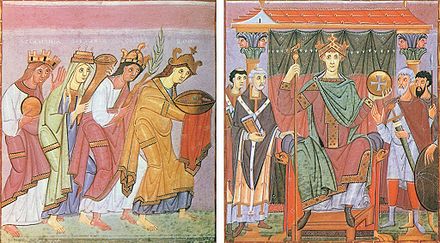Sphaira

The Sphaira (from Greek σφαῖρα , Latin sphaera "shell, ball", in particular " celestial sphere "), also called spherical sphere , was the attribute of the Titan Atlas in classical mythology and in the Roman Empire was in the form of the globe from divine to imperial power symbol and Symbol for world domination . At the end of the 4th century AD , another change in meaning took place when the Sphaira on coins and seals, together with the cross, was stylized as a symbol of power for the now Christian emperors.
In continuity with its ancient meaning, it was taken over by the grace of God with a cross as a sign of Christian rule , in the medieval iconography of the rulers of the Holy Roman Empire , in which it was next to the crown - since Otto I and Conrad II the imperial crown - , Scepter as well as other objects formed a rule attribute of the Roman-German kings and emperors .
Like the Sphaira symbolized also it detaches in the 11th century orb , the imperial idea , but this is now not represented as it was before the spheres ball the heavens , but the earth and was later known as orb of the Holy Roman Empire part of the imperial regalia .
literature
- Percy Ernst Schramm : Sphaira, globe, orb. Migration and change of a symbol of rule from Caesar to Elizabeth II. A contribution to the “afterlife” of antiquity . Hiersemann, Stuttgart 1958 ( review by Iso Müller ).
Web links
- Spheres ball , in: The large art dictionary by PW Hartmann